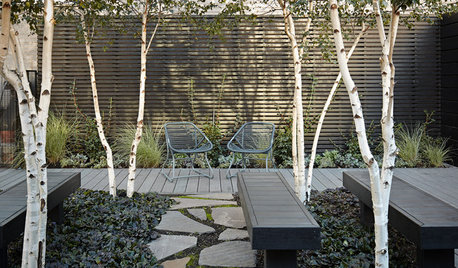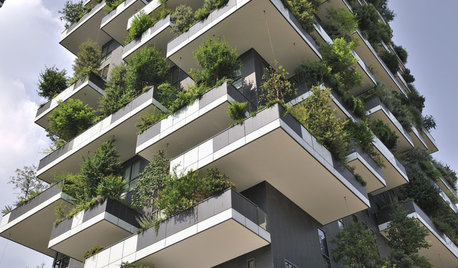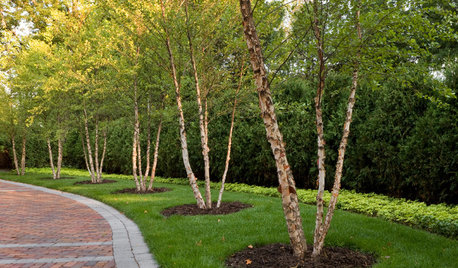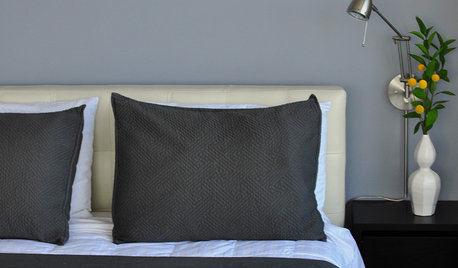No-mess shade tree for A/C unit?
sarabell
15 years ago
Related Stories

PETSDealing With Pet Messes: An Animal Lover's Story
Cat and dog hair, tracked-in mud, scratched floors ... see how one pet guardian learned to cope and to focus on the love
Full Story
LANDSCAPE DESIGN7 Great Trees for Summer Shade and Fall Color
These landscape-pro faves straddle the seasons beautifully. Could one enhance your own yard?
Full Story
LANDSCAPE DESIGN5 Ways to Use Trees to Create a Sensational Garden Space
Trees define spaces in multiple ways and bring a layer of shade and intrigue to the landscape
Full Story
LANDSCAPE DESIGNGreat Design Plant: Retreat to the Shade of Hardy Catalpa
Big foliage and a towering height provide a shady respite in summer, but that's not all hardy catalpa offers dedicated gardeners
Full Story
THE ART OF ARCHITECTUREWorld of Design: Trees Bring Nature to a High-Rise in Milan
Discover ‘the most beautiful and innovative skyscraper in the world’ — the foliage-filled Bosco Verticale — and tour one of its apartments
Full Story
MOST POPULAR5 Ways to Hide That Big Air Conditioner in Your Yard
Don’t sweat that boxy A/C unit. Here’s how to place it out of sight and out of mind
Full Story
LANDSCAPE DESIGNGreat Design Plant: River Birch
Pick this rugged native tree for its intriguing peeling bark, soil adaptability or leaves that bring dappled shade to a garden
Full Story
SPRING GARDENING7 Spectacular and Practical Spring-Flowering Trees
Put on a beauteous show in the garden with a landscape tree awash in flowers — just do your homework first
Full Story
MOST POPULAR50 Shades of Gray
Gray is hotter than ever, thanks to a hit novel full of risks and dark secrets. Tell us: Which paint shade possesses you?
Full Story
FALL GARDENING6 Trees You'll Fall For
Don’t put down that spade! Autumn is the perfect time for planting these trees
Full StoryMore Discussions







ken_adrian Adrian MI cold Z5
Marie Tulin
Related Professionals
Manhattan Beach Landscape Architects & Landscape Designers · Port Royal Landscape Architects & Landscape Designers · Surprise Landscape Contractors · Alamo Landscape Contractors · Chesapeake Ranch Estates Landscape Contractors · Davidson Landscape Contractors · Garland Landscape Contractors · Pahrump Landscape Contractors · Pikesville Landscape Contractors · Four Corners Landscape Contractors · Ankeny Decks, Patios & Outdoor Enclosures · Athens Decks, Patios & Outdoor Enclosures · Atlantic City Decks, Patios & Outdoor Enclosures · Hayward Decks, Patios & Outdoor Enclosures · Woodland Hills Decks, Patios & Outdoor Enclosuresalabamatreehugger 8b SW Alabama
sarabellOriginal Author
Marie Tulin
lucky_p
sarabellOriginal Author
Pamchesbay
noki
sarabellOriginal Author
sarabellOriginal Author
lucky_p
lou_spicewood_tx
sarabellOriginal Author
alabamatreehugger 8b SW Alabama
sarabellOriginal Author
sarabellOriginal Author
lucky_p
brandon7 TN_zone7
lou_spicewood_tx
sarabellOriginal Author
lou_spicewood_tx
lou_spicewood_tx
sarabellOriginal Author
markinspringborooh
sarabellOriginal Author
scotjute Z8
sarkeizen
mdvaden_of_oregon
gtjon
Marie Tulin
markinspringborooh